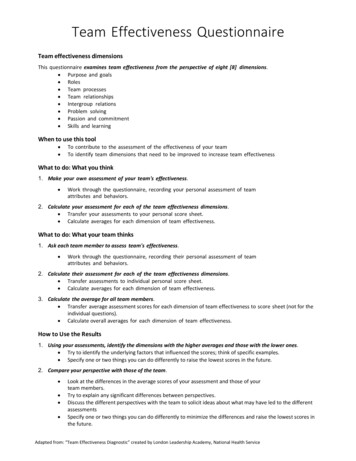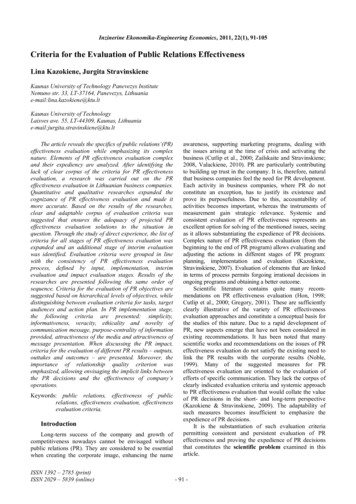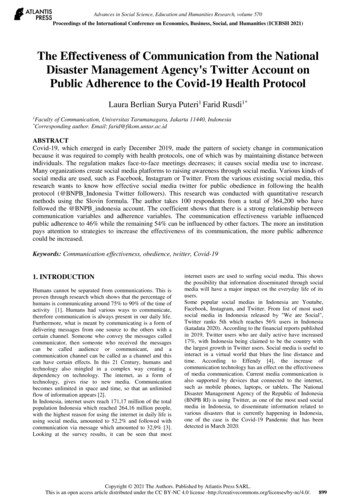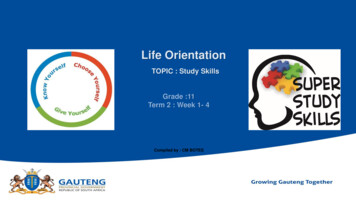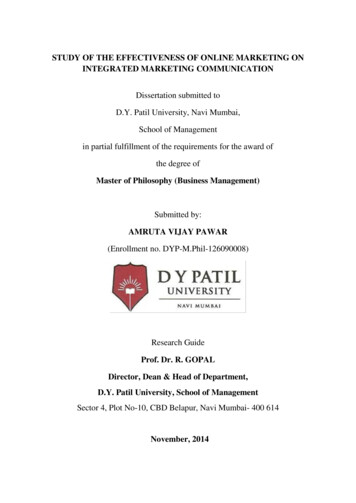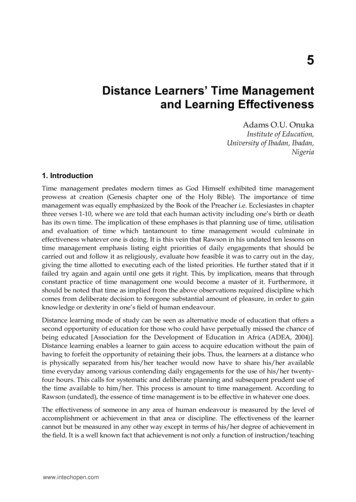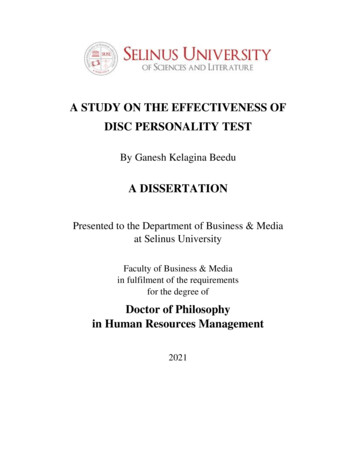
Transcription
A STUDY ON THE EFFECTIVENESS OFDISC PERSONALITY TESTBy Ganesh Kelagina BeeduA DISSERTATIONPresented to the Department of Business & Mediaat Selinus UniversityFaculty of Business & Mediain fulfilment of the requirementsfor the degree ofDoctor of Philosophyin Human Resources Management2021
DECLARATIONThe dissertation titled “A STUDY ON THE EFFECTIVENESS OF DISCPERSONALITY TEST” submitted for the Award ‘Doctor of Philosophy in HumanResources Management’ at Selinus University of Sciences and Literature, Facultyof Business and Media; is my original work.“I do hereby attest that I am the sole author of this project/thesis and that its contentsare only the result of the readings and research I have done.”Date: 22/04/2021STUDENT SIGNATUTEStudent-ID : N unise1329it
ACKNOWLEDGEMENTI am thankful to University of Selinus for giving me an opportunity to pursue thisDoctorate in Human Resources Management. I am grateful to Prof. Salvatore Fava,Dr. Adriana Nifosì and Ms. Elvira Di Mauro of Selinus University for supportingme in completing this thesis. I also express my deep sense of gratitude to the GreatArchitect of the Universe, my family members, friends & colleagues who havedirectly and indirectly supported me during this study.Signature of Student: Ganesh Kelagina BeeduSTUDENT ID: N unise1329it
TABLE OF CONTENTSTitle PageDeclarationAcknowledgementTable of ContentsList of TablesList of ChartsAbstract1234567Chapter 1 – Introduction1.11.21.31.41.51.6IntroductionResearch QuestionsResearch ObjectivesJustification for the studyScope of the studyMethodology of the study81011111212Chapter 2 – Literature Review2.12.22.32.3.12.3.22.3.32.3.4Personality TestDisc Personality TestHistory of DISC personality AssessmentDISC Circle – Four Dimensions of BehaviorBenefits of DISC Personality TestStudy of published Case Studies in DISC AssessmentDISC Personality Test – Analysis of Criticisms13141618313355Chapter 3 – Research tionDesign of the studyPopulation of the studySample and Sampling TechniqueSampling SizeInstrument for Data CollectionValidation of the InstrumentReliability of the InstrumentAdministration of the InstrumentMethod of Data Analysis61626263636464646565Chapter 4 – Data Presentation, Analysis, and Interpretation4.14.2IntroductionData Analysis6565Chapter 5 – Discussion of onDiscussion on FindingsConsequence of the studyConclusionRecommendation for further study888993949495103
LIST OF TABLESTable ularsPage No.66Age Group of the respondents67Gender of the Respondents68Nationality of the Respondents70Qualification of the Respondents71Work Experience of the respondents72Profession73Personality Profile derived from the test74The above profile matches my personality75The test is not complicated and simple to use77The test result has helped me in understanding myself78Through this test I understood my core strengths80Through this test I have understood my area fordevelopment81This test is a very good tool for Assessing individuals83This test is very useful for recruiting right candidates84This test can be used for Team Building purpose85This test is very useful for motivating employees87How many STARS you will give to this DISC Test
LIST OF CHARTSChart NoIIIIIIIVVVIVIIVIIIIXXXIXIIXIIIXIVXVXVIXVIIFigure 1ParticularsPage No.66Age Group of the respondents67Gender of the Respondents69Nationality of the Respondents70Qualification of the Respondents71Work Experience of the respondents72Profession73Personality Profile derived from the test74The above profile matches my personality76The test is not complicated and simple to use77The test result has helped me in understanding myself79Through this test I understood my core strengths80Through this test I have understood my area fordevelopment82This test is a very good tool for Assessing individuals83This test is very useful for recruiting right candidates84This test can be used for Team Building purpose86This test is very useful for motivating employees87How many STARS you will give to this DISC Test18
ABSTRACTThis research is conducted to assess the effectiveness of DISC Personality Test. TheDISC assessment determines where you fit in four DISC factors: dominance,influence, steadiness, and compliance. DISC is one of the most prevalent andauthoritative career assessments out there, and many organizations encourage theiremployees to take it. Many websites and firms offer DISC personality tests, and fewimportant sites/companies among them are ‘123 Test’ ‘Crystal’, ‘InterpersonalSkills Self-Assessment (https://www.skillsyouneed.com ), ‘TestQ.Com’ and‘Sokanu’, ‘Extended DISC’. The objectives of this research were to know whetherthe DISC personality test reveal the correct personality profile of the users, to studythe user-friendliness of the test instrument, to explore the usefulness of DISCassessment in recruitment, training and development, team building and employeemotivation. The researcher used a combination of primary and secondary dataevaluation and quantitative analysis in this study. From a population of 7000 persons385 persons were selected for survey. The Researcher calculated the sample size byusing Taro Yamane formula with 95% confidence level. The respondents wereasked to undergo DISC personality test and were asked to answer the surveyquestions. All the 385 persons participated in the survey. In addition to the surveythe researcher studied the published success stories, real case studies and criticalarticles written by behavioural scientists. The data collected were presented in tablesand analysed using simple percentages and frequencies. Through this study theresearcher proved that the DISC Personality test is very effective, and this tool canbe used for recruitment, team building, training, and employee motivation.
CHAPTER 11.1 IntroductionPersonality testing has become an enormous activity in the present organizations andhas been observed to develop at a substantial percentage. Many organizations usepersonality testing as a means of evaluating the characteristics of both their presentand future employees, with the outcomes being used for wide-ranging purposes.Personality assessments are designed to deliver organizations with information on aworker’s behavioural style and in what way it is probable to affect their performanceat work. The Employers can better know their employees’ behaviours and roleswithin their organization by using personality tests. Personality tests can beextremely valuable to all employers across numerous organizations. Researchconfirms that well developed personality assessment can efficaciously forecastemployee performance across the eclectic array of job types.Personality is meaningful to management because employees' personalities maydictate how well they do their jobs. Personality may indicate how hard an individualwill perform, how systematized they are, how well they will interact with others, andhow talented they are. If the employers want an employee to contribute implicitly totheir organization, it would be a blunder to overlook the importance of culture fit. Amisalliance between the company’s culture and an employee’s personality can resultin miscommunication, poor productivity, and disengagement. From anorganizational stance, this error can lead to high attrition, which is expensive andproblematic.Many behavioural scientists have developed Psychological tests and noteworthyamong them are Disc, True Colours, Myers-Briggs Type Indicator, 16 PF, Hexaco,NEO personality inventory, Eysenck Personality Inventory, Minnesota Multiphasic
Personality Inventory, The Birkman Method, Hogan Personality Inventory andCaliper Profile.There are hundreds of personality tests available in net, free as well as paid. Someof these tests label you with a general personality type, while others delve into yourbest potential career paths. Some challenge you to look at ink blots, while others askyou detailed multiple choice questions. While many of these tests are undependableand don’t offer any factual scientific validation, others can deliver potentially astute,psychologically based insight into your behaviours, ambitions, and temperament intimes of conflict.Some online personality tests are stimulating indicators into why you makedecisions, who you work well with, and how to modify your attitude towards peoplewhose personalities clash with yours. In both your work and personal life, thisinformation can be invaluable.Even though the internet is flooded with free as well as paid personality tests, no onehas evaluated the effectiveness of these tests so far. Most of the organizations utilizepaid tests for better results and to avoid any performance issues. The free tests aretaken by individual users either for fun or to just experiment.DiSC is a personal assessment tool used by more than one million people every yearto help enhance teamwork, communication, and productivity in the workplace. DiSCassessments are used in thousands of organizations around the world, from extensivegovernment institutions and Fortune 500 companies to NGOs and small businesses.The DiSC personality tests help organizations to build stronger, more effectiveworking relationships. DiSC is an abbreviation that stands for the four main
personality profiles defined in the DiSC model: (D)ominance, (i)nfluence,(S)teadiness and (C)onscientiousness.Many websites and firms offer DISC personality tests, and few importantsites/companies among them are ‘123 Test’ ‘Crystal’, ‘Interpersonal Skills SelfAssessment (https://www.skillsyouneed.com ), ‘TestQ.Com’ and ‘Sokanu’, ‘ExtendedDISC’.1.2 Research QuestionsThe main aim of this research is to find out the effectiveness of DISC personalitytest and to what extent this tool helps the people. Precisely, the research will be ableto deliver answers to the following research questions:1.To what extent the DISC personality test effective in defining individual’spersonality profile?2.Does this test reveal the accurate personality profile of an individual?3.Is this test simple to use or user-friendly?4.What is the perception of users on effectiveness of this test?5.Whether the DISC test can be used to get desired results in recruitment?6.Whether the DISC test can be used for team building or employeemotivational purpose?1.3 Research ObjectivesThe main aim of this research is to explore the effectiveness of DISC personality testin delivering results to individuals as well as organizations. Through this study thebelow objectives will be achieved:
1.The opinion of DISC Personality test users in knowing their personalitymodel and accuracy of the test.2.To investigate the user-friendliness of this test.3.To study the opinion of users regarding the effectiveness of this test inknowing their strengths and areas for development?4.To know whether this test can be used for organizational needs likerecruitment, team building and for formulating motivational programs.1.4 Justification for the studyThere are numerous personality tests are available online/paper and these tests areused by students, job seekers, HR professionals, researchers, Universities etc forvarious purposes. The DISC personality test being one of the prominent tests, usedwidely across the world and believed to be very useful in revealing the individual’spersonality models. The DISC test is used by many organizations for their businesspurposes. There are reviews / criticisms both in favour and against this test. Thesereviews/criticisms are derived from the discussions happened between behaviouralscientists and management professionals or through the analysis of customer reviewspublished by various websites/book publishers. Since majority of the experts andcustomer reviews are in favour of this test, the researcher attempted to do an in-depthstudy by analyzing the articles written by experts and customer reviews and byconducting a survey of test users.1.5 Scope of the studyThis study covers the effectiveness of the DISC personality Test in delivering resultsin recruitment, self-assessment, team building and employee motivation. The study
covered the direct test users from different countries, published customer reviewsand articles written by behavioural experts.The methodology section will provide detail discussion of the sample population andthe study area and justification for their choice.1.6 Methodology of the studyTo address the main research objectives, this research used quantitative method andcombination of primary and secondary sources. The respondents were administeredDISC personality test and collected their feedback through a survey. Also, collectedthe data by analyzing the case studies conducted by individuals/organizations,reviews / comments written by test users and behavioural experts.
CHAPTER 2LITERATURE REVIEW2.1 Personality TestPersonality traits play a crucial role in leadership and team dynamics (Lykourentzouet al., 2016). Personality type and measurement are vital to organizations in creatingeffective leaders, individuals, and team performance (Colbert et al., 2014;Lykourentzou et al., 2016). Jeong et al. (2012) considered that knowing anindividual’s personality prior to team formation increased team productivity andminimized conflict. A personality test is a method of evaluating human personalityconstructs. Personality assessment is the evaluation and measurement ofpsychological traits, interests, values, worldviews, and identity with personalbehavioural characteristics (Price, 2015). Personality testing and assessment refer totechniques designed to measure the distinguishing patterns of behaviours that peopledisplay across various circumstances. In other words, it is a systematic procedure forobtaining samples of behaviour, relevant to cognitive or affective functioning, andfor scoring and evaluating those samples according to standards. Personality testscan be used to help clarify a clinical diagnosis, guide therapeutic interventions, andhelp predict how people may respond in different situations. Knowing personalitytypes and traits includes personal habits, thought processes, and behaviours,enabling maximum effectiveness in a team (Freeman, 2009). Personality type is theentirety of a person’s emotional and behavioural individualities, or characteristicsthat is an instrumental and consistent variable of interactive and complimentarydynamics (Abu-Raiya, 2014; Pradhan et al., 2015).
The first personality assessment actions were developed in the 1920s and wereenvisioned to ease the process of personnel selection, mainly in the armed forces.Since these initial efforts, an extensive variety of personality scales andquestionnaires have been developed.2.2 Disc Personality TestDiSC is a personal assessment tool used to improve work productivity, teamwork,leadership, sales, and communication. DiSC measures personality and behaviouralstyle. Freeman (2011) described the DISC as a behavioral model consisting of fourdimensions, all equally important, with the majority of people scoring in a blend ofpersonality styles of Direct/Driver (D), Influence/Inspire (I), Steady/Stable (S), andCorrect/Compliant/Conscientious (C).It does not measure intelligence, aptitude,mental health, or values. According to Kevin Kruse “The DiSC assessment is thepersonality test that can unlock your potential as a leader, improve yourcommunication at work and at home, and lead you to unlock the deeper insights ofself-awareness”.Many behavioural models focus on what is wrong with a person to identify"personality disorders." The DISC model is based on normal behaviour, notabnormal behaviour. DISC is a "wellness model" that is objective and descriptiverather than subjective and judgmental (Robert A. Rohm).The DiSC model of behaviour was first outlined by psychologist William MoutonMarston in his 1928 book, "Emotions of Normal People." DiSC centers on fourdifferent personality traits which are currently Dominance (D), Inducement (I),Submission (S), and Compliance (C). This theory was then developed into abehavioral assessment tool by industrial psychologist Walter Vernon Clarke.
DISC profiles are one of the best (and most widely used) profiling vehicles to rsonalitytesting-characteristically categorized by a short-forced choice questionnaire formatconstructed around four fundamental dimensions - is a multi-million-poundindustry. Completed by over 10 million people each year in recruitment, personaldevelopment, coaching and team building.The DiSC assessment assists employees in identifying their growth areas and it givesyou nearest to the accurate results. (Sharmila Sinha – 2020). More and more peopleare coming over to DiSC from Myers and Briggs primarily because it is very easyto use. Also Myers and Briggs evaluates 16 personality styles whereas DiSCevaluates 354 behavioural styles. Disc is much more robust, much more analyticaland it is very easy to use (Greg Smith, 2016). According to Christina Bowser “DISChas no value judgement of good or bad, better or worse. All the styles have strengthsand areas of development. Each of us have our own unique combination of stylesthat feels more comfortable and some that take more energy”.2.3 History of DISC personality AssessmentEmpodocles in 444 BC spoke about four external elements which affect thebehaviour of people and those elements are, Fire, earth, air, and water. Theseexternal elements influence how people act. In 400 BC Hippocrates believed that thepersonality was impacted by internal fluids (Chloric, Sanguine, Phlegmatic andMelancholy). In 1921 Carl Jung narrated that the personality was tied to four thoughtprocess and those elements are thinking, feeling, sensing and intuition. There on,psychology moved at a fast pace, but it wasn’t until 1921 that there was anydevelopment towards DiSC. In 1921, Carl Jung attributed the personality differencesto the way in which we think and process information. He came up with four styles
– Thinking, feeling, sensation and intuition which are now employed in the MyersBriggs Personality Test (Strengthscape). The definitions of these types are rooted inJung's lifelong work on the unconscious mind, and need not concern us here. Theyare important because they represent one of the first serious attempts to map thehuman personality by a modern psychologist (DISC: History and Development Discus).Dr. William Moulton Marston, a psychologist with a Ph.D from Harvard, firstproposed his theories that have progressed into the modern DiSC system in his book,"Emotions of Normal People" written in 1928.Dr. Marston created this work as an attempt to describe how a person’s emotionsmight lead to different group interactions, and how these might change over time.He wanted to help people understand how their own behaviour patterns affected theirinteractions within a group, and how to manage those behaviours. This was theoriginal creation of the 4 primary components of personality named by Marson asDominance, Inducement, Submission and Compliance.The DiSC system was first shaped into a personality assessment in the 1950’s byWalter V. Clarke, an industrial psychologist. The assessment at first was somewhatprimeval - first, a series of adjectives were chosen by applicants that best describedthemselves, then a series of yes-no questions were answered.Currently, there are at least fifty establishments who use a descriptive behaviouraldevice based on the Marston theory. DISC is public domain material, but individualcompanies have copyrighted the material that they have developed. Marston-basedinstruments like the Style Analysis have been used by over 30 million peopleworldwide. They have earned the respect of many professionals for accuracy andvalidity ( GET SAVVII -Unlocking the power within) .
2.3.1 DiSC Circle – Four Dimensions of BehaviourThe initial representation of the DiSC model, as described by William Marston inhis book, The Emotions of Normal People, was a circle. Marston identified what hecalled four ―primary emotions and associated behavioural responses, which todaywe know as Dominance (D), Influence (i), Steadiness (S), and Conscientiousness(C). Even though some people incline equally toward all these dimensions, researchindicates that most of us lean toward one or two.Figure 1. DiSC CircleDominance (D Style)Dominance is one of the personality traits which is even seen in the forces of nature.According to Watson, dominant type of behaviour constitutes an inherent or
unlearned emotional response. The dominance is an emotional response which isevoked by an antagonistic motor stimulus of inferior intensity to the motor self ofthe subject (William Moulton Marston). The domination of weaker by the strongeris self-evident. Dominance seems to comprise the most fundamental and primitivetype of emotional integration found in animals or human beings (William MoultonMarston). Dominance behaviour is a common phenomenon in animals that causesdifferential access among conspecifics to food and other limiting resources (Wilson,1975).Dominance may be said to constitute by far the largest and most vital part in theemotional influence upon the behaviour of all children for the first three to five yearsof life, and of a great majority of males from birth to death. Dominance is found tobe the theme expressed in countless monuments, sculptures, musical compositions,and other works of art (William Moulton Marston).Since our civilization is manmade, dominance is possibly the emotion mostvenerated by both genders. Dominance emotion is a mixture of pleasantness andunpleasantness throughout each dominant response. Dominance is found to be thetheme expressed in uncountable monuments, sculptures, musical compositions, andother works.Dominance emotion has been named "ego-emotion ", “aggressiveness", " fury ","rage ", "self-assertion ", "initiative ", "will", "determination", "high spirit", "selfseeking", "courage ", "nerve ", "boldness ", "dare-deviltry ", "purposiveness","persistency ", "unconquerable ", "stick-to-itiveness ", "go-getiveness ", "force ofcharacter ", "force ", "power ", "pioneer spirit ", "strength of character", "strength ","stubbornness ", "bulldog character ", "doggedness ", "fighting instinct", "instinct of
self-preservation", "superiority complex ", "ego-centricity ", and many other nomdeplumes (Alfred Adler).The people with dominant personality like to take control of over situation. Theyenjoy bossing people around. They are extremely task oriented and focused onachieving goals. They don’t have desire to hurt or control others’ lives but simplybeing able to take charge and get the things done in case need arises. Dominantpersons are extremely important to businesses. Submissive people in an organizationor society enjoy being dominated by others and taken care. The dominantpersonalities are forceful and most assertive. They are direct, results oriented,competitive and strong willed. They move fast and get the things done immediately.They like challenges and multitasking. They want to create change and don’t likeroutine life. The personality trait dominance involves the tendency to behave inassertive, forceful, and self-assured ways (Buss & Craik, 1980; Gough, 1987;Wiggins, 1979). They want to be in charge and want power and control over others.They always communicate in one direction. They would like to talk and others tolisten. At times they express their own opinions as facts thus cutting discussions.They are impatient listeners and tend to interrupt. They want to make independentdecisions and implement them quickly. Since Dominant style persons don’t wantmore information and take decisions swiftly, they are more likely to make wrongdecisions. However, they overcome their mistakes quickly and move on by keepingbig picture in their mind. Under pressure they show lack of concern for othersbecause they are focusing on the tasks, due to this, others perceive ‘Dominant’personalities as too aggressive, blunt, and even rude. At times they can be impatientand overbearing. ‘Dominant’ personalities succeed by being decisive, taking risksand focusing on big picture, results, and goals.
The Type ‘D’ personalities are also called ‘Captain’. In general, they are assertive,ambitious, and intense. ‘D’ personalities are usually pragmatic, result orientedexecutors who work quickly and make decisions with firmness and objectivity. Asan abundance of research has shown, individuals higher in trait dominance tend toattain more influence in face-to-face groups than others—they speak more, gainmore control over group processes, and hold disproportionate sway over groupdecisions (for a review, see Judge, Bono, Illies, & Gerhardt, 2002). They tend to beresourceful, strong-willed, and self-reliant in pursuing goals. They enjoy engagingothers in competitive situations. The “D” type person seeks out challenges andcompetition, and dominant people are usually convinced that they can achieve theirobjectives by using logic and their arguments (Manion, 2012).The Dominant personalities place high expectation on performance from themselvesand others. They enjoy lively debates and resists influence from others. Dominantpersons act in ways that make them seem both expert at the task and socially skilled,which leads groups to afford them encouragement and control. Dominant individualsachieve influence by exhibiting self-confidence and apparent competence. Peoplewith a high dominant trait tend to be direct, assertive, independent, and usually solveproblems using a quick and active approach (Bradberry, 2007).Dominance encompasses using power, coercion, and pressure in group situations.Dominance works as an instrument to attain power, if not respect, but normallydouses a group’s well-being. Dominant workers lean towards to exhibit arrogance,superiority, and conceit. They have higher-than-average levels of aggressive,disagreeable, manipulative personality traits. Dominant people also score highly inthe traits known as the ‘dark triad’: Machiavellianism, narcissism, and psychopathy.In groups, dominant members tend to view others as either allies or foes, to evaluatepeople’s usefulness in attaining goals, and to show a hunger for power.
Leaders high in dominance go to great lengths to protect their power, even at thecost of the group. They want to strongarm others through reward and punishment.They often view talented group members as threats. Groups seem to prefer dominantleaders in the face of conflict between their group and some outside group. The traitsof a dominant leader (aggressiveness, power-hungriness) may be more attractive inthese situations than a prestige leader with traits like altruism, which may be seen asweak. Moreover, in the face of such a conflict, dominant leaders curb their moredestructive tendencies to their own group members.The first step to deal with dominant personalities is to be blunt and direct. The secondstep is to confront them with facts and evidence because they don’t like to argue withfacts. Third step is to give them opportunity to withdraw gracefully and in safe phase.Influence (I Style)The Influence Personality Style in the DISC model by Dr. William Marston is notafraid to be the center of attention. Also known simply as 'I'. Influence is associatedwith a sunny, friendly and extrovert approach, warm and open to other people,enthusiastic, optimistic, talkative, persuasive, impulsive, emotional, sociable, andgregarious. This DISC type will trust others naturally, truly enjoys being aroundothers, and function best when around people and working in teams. The Influencestyle (i) is fast-paced and accepting, most reported as ‘lively and outgoing’ (NikkiMilne, 2019).Someone with an Influence (i) style aims to shape his or her environment byinfluencing or persuading others. This person values openness, friendship andbuilding relationships (Nicole Fallon, 2015). This DISC type tends to act verypersuasive and when in conflict, they will tend to attack not physically but verbally.This style thrives off of approval and they need to have approval (Mike Proctor2019). They enjoy and get energized by collaborating with others and tend to be very
entertaining people. Their primary emotion is optimism (Process & PeopleConsultancy, 2018). Their primary drive is interaction. They want to talk, they wantto entertain and engage other people (Mike Proctor 2019).At work the ‘I’ style personalities are strong team motivators. They bring optimismand enthusiasm to the groups (Process & People Consultancy, 2018).Theirpreferred task is people oriented and they are very comfortable in social, friendlinesssituations. The ‘I’ personalities expect freedom from control. They want to be thelife of the party or they want to be the center of attraction (Mike Proctor 2019). Theyare natural born leaders and will inspire others to do better (Church consultants,2013). Even though the ‘I’ personalities are optimistic, they exaggerate. They arepersonable but are manipulative. They are enthusiastic but can become impulsiveand even little obnoxious. When experiencing extreme pressure, they may tend tofocus more on people and overlook details and tasks.Those with ‘I’ personality trait will approach problems with creativity and provideoutside the box solutions. If conflict arises, they will step in to negotiate a solution.However, if the conflict involves them directly, they may avoid it to maintainharmony in the relationship (Process & People Consultancy, 2018). Since they aresociable and expect approval, a lot of times they will talk without thinking. They areusually disorganized and very non-traditional in their approach. They measure theirself-worth through compliments, acknowledgements (Mike Proctor 2019). They willdeal with c
2.1 Personality Test 13 2.2 Disc Personality Test 14 2.3 History of DISC personality Assessment 16 2.3.1 DISC Circle -Four Dimensions of Behavior 18 2.3.2 Benefits of DISC Personality Test 31 2.3.3 Study of published Case Studies in DISC Assessment 33 2.3.4 DISC Personality Test -Analysis of Criticisms 55




